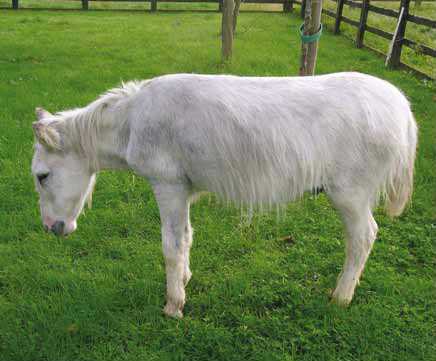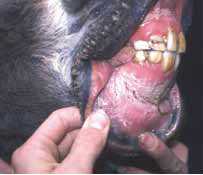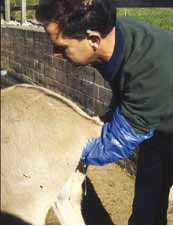Dull Donkey
Introduction
The donkey and horse are closely related, and many of the conditions that affect them are very similar. However, the detection of sickness or disease in the donkey can be made more difficult by its stoical nature. Dullness and depression may be the only symptoms exhibited. These subtle behavioural changes may also be accompanied by anorexia. Subtle changes in performance that can be early indicators of disease in sporting or racehorses are frequently impossible to detect in the donkey, as most UK donkeys lead a sedentary lifestyle as companion animals. This can unfortunately mean that the donkey may be in the advanced stages of a disease before a diagnosis is reached. The attending veterinary surgeon should therefore regard the call to a dull donkey as a call to a potentially very sick animal. This page focuses on the approach to the diagnosis of the cause of the dullness. Click to see the causes of dullness at The Donkey Sanctuary.
There may also be other sub-clinical diseases in the dull donkey that may not be apparent to the veterinary surgeon even after clinical examination, complete blood count and biochemical analysis. For example, low-grade pain due to laminitis or arthritis may be occurring and may remain undiagnosed until the disease process is more advanced.
Apparent dullness may sometimes be normal behaviour for donkeys as they are naturally quiet animals.

Signalment
The following points should be considered when the practitioner is asked to examine a dull donkey:
- Normal behaviour
The apparent dullness may be normal behaviour for that donkey. This can be best assessed by discussion with the owner.
- Sex
A female donkey may be pregnant and therefore dull due to peri-parturient problems.
- Age
The geriatric donkey will be more likely to suffer from diseases such as arthritis, dental disease, laminitis, chronic respiratory disease, tumours of various origins and also neurological changes resulting in senility.
History
- Previous disease
If a donkey has suffered from previous bouts of laminitis, it may be more likely to develop the condition again. A history of liver or kidney disease may also be significant as the condition may have recurred or become more serious.
- Previous treatment
If the donkey has recently received treatment for another condition, such as dental disease, this may make the donkey reluctant to eat, hence predisposing to hyperlipaemia.
- Separation from a friend
Donkeys often become very bonded to other donkeys and can also bond with other animals such as horses, goats, sheep, etc. If the friend dies or is taken away, the donkey will frequently pine. This can lead to reluctance to eat, predisposing to hyperlipaemia. If one member of a closely bonded pair of donkeys is euthanased, leaving the remaining donkey with its recumbent friend for at least half an hour can help the donkey accept that its friend has gone.
- Change of environment or management
Donkeys often remain within the same home for a large part of their lives and if they are moved to another home they seem to suffer apparent stress, which may predispose to disease. Donkeys in the UK do not commonly attend shows or mix with large groups of other equines and are thought to remain naïve to many of the equine respiratory disease viruses. Movement and mixing of donkeys may predispose to the recrudescence of herpes viruses in latently infected animals, allowing infection of the previously unexposed donkeys.
Diagnosis
The assessment of the following parameters should be regarded as essential in the dull donkey and further examinations and tests may be indicated, depending on the clinical findings and progression of the disease.
Clinical Signs
- Demeanour
As mentioned under signalment, the normal behaviour for that particular donkey should be considered. Is the donkey alert and responsive to stimuli? Does the donkey seem weak or ataxic? Is the donkey showing any signs of abdominal pain? Symptoms such as rolling with abdominal pain may not be as common in the stoical donkey as they are in the horse. A donkey in pain will often stand with its head lowered, lie down or not respond as it normally would. Rolling has previously only been recorded in 8% of donkeys with intestinal impactions (Duffield et al, 2002).
- Appetite
Assessment of a dull donkey’s appetite is very important. The donkey should be offered the type of food it is used to eating. ‘Sham feeding’ is common in the sick donkey, so actual intake should be measured. If the donkey is reluctant to take its usual food, then the addition of grated apples and carrots, small amounts of peppermint cordial or un-molassed sugar beet may be useful to tempt fussy eaters. Brambles may also tempt an otherwise inappetent donkey.
Prehension, mastication and dysphagia can be assessed while observing the donkey eating. In the elderly donkey, dental disease should be considered an important differential for reluctance to, or difficulty with, eating. Total anorexia should be regarded as a very serious clinical sign in the donkey as it will lead to hyperlipaemia. Anorexia has been recorded in 76% of donkeys with impactions (Duffield et al, 2002).: In another study, 45% of donkeys with impactive-type colic presented with reduced appetite (Cox et al, 2007, 2008).
- Rectal temperature
The normal rectal temperature of the adult donkey has been found to be slightly lower than the rectal temperature of the adult horse, with the average being 37.1°C (range 36.2-37.8°C). Elevations may occur due to physical exertion or response to infection. Pyrexia is a possible cause of dullness. In H. Duffield's experience, donkeys with significant pyrexia may only show subtle changes in demeanour.
- Cardiac auscultation and pulse rate
Auscultation of the heart, the heart rate and the character of the pulse are useful for assessing cardiovascular status and the presence of heart failure. The normal heart rate for an adult donkey is considered to be 44 beats per minute on average. It should be considered that donkeys may cope better with dehydration and hypovolaemia due to their adaptations to arid environments.
- Respiratory tract auscultation and respiratory rate

In H. Duffield's experience, the normal respiratory rate for the donkey is similar to that of the horse, i.e. 16 to 20 breaths per minute. Severe abdominal pain may increase the respiratory rate in an apparent attempt to reduce the movement of the diaphragm and chest. Pressure on the diaphragm from a grossly distended colon will also elevate the respiratory rate. An elevation in respiratory rate, accompanied by cyanosis, should be considered as evidence of very serious disease. An increase in respiratory effort with involvement of the abdominal muscles may also be a significant indicator of respiratory disease.
- Mucous membrane colour
In the donkey the oral mucous membranes are normally pale pink but with less of a yellow tinge when compared to the horse. Dehydration can lead to blanching of the mucous membranes and with subsequent venous congestion or endotoxin release they may become brick red and even cyanotic. A degree of pallor may sometimes be observed in the elderly donkey and, in H. Duffield's experience, is normal. Gingivitis due to severe dental disease may also lead to a change in the colour of the gums. If this is the case other mucous membranes may be more suitable for diagnostic purposes. The capillary refill time can be used to assess tissue perfusion and cardiovascular performance.
- Examination of the oral cavity
This should be carried out using a Hausmann’s gag. In the elderly donkey with few or no incisor teeth the use of diastaema plates is preferable. Loose teeth, sharp edges leading to labial or lingual ulceration, displaced teeth and the presence of a ‘shear mouth’ can all lead to the reluctance or inability to eat which may predispose hyperlipaemia and therefore dullness. It should also be noted that even obese donkeys may have significant dental disease.
- Ocular examination
Impaired sight, commonly caused by chronic corneal or lens pathology, may lead to dullness, especially if the donkey’s environment or management has changed.
- Musculo-skeletal system examination
Donkeys with conditions such as acute laminitis or white line abscesses may initially present as dull and reluctant to move or eat. Chronic laminitis and arthritis may also lead to the donkey becoming progressively more depressed. The gait should be assessed and the feet examined for increased digital pulses and solar pain.

- Abdominal auscultation
The character of normal borborygmi in the donkey is essentially similar to that in the horse. The presence or absence of normal sounds may assist in the diagnosis of gastro-intestinal disorders.
- Rectal examination and abdominal palpation
A rectal examination should be part of the routine clinical examination of the dull donkey and the practitioner should not avoid this procedure due to the small size of the donkey. To avoid problems, ensure plenty of lubricant, adequate restraint, careful introduction of the hand and check the rectal sleeve for blood. Alpha-2 agonists may be used to facilitate rectal examination but are rarely necessary in H. Duffield's experience and may be counter-productive as they may interfere with gut motility.
Upon rectal examination it is possible to assess faecal output, colour and consistency, which may indicate certain pathological conditions. Dry, hard, mucous-covered droppings are frequently observed in hyperlipaemic donkeys and the rectal mucosa is often very dry. In these cases a thorough rectal examination should be carried out with great care as the mucosa may be more prone to tearing. Donkeys with large intestinal impactions may have little or no faecal output and the impactions themselves may be palpable per rectum especially if the impaction is in the pelvic flexure. Displacement or distension of the intestines should also be assessed. See Alimentary Diseases.
Laboratory Tests
Blood tests
Complete blood count and biochemical analysis allows diagnosis of the following abnormalities, which may be causing the dullness:
• Hyperlipaemia (This may also be diagnosed by visual assessment of the blood sample. A triglyceride assay may not be included on a routine profile and may need to be specifically requested.)
• Hepatopathy
• Renal disease
• Pancreatitis
• Anaemia
• Immune responses to infection
• Myopathy
• Hyopalbuminaemia
Re-examination and re-assessment
If a disease process is identified and treatment is undertaken, re-examination and reassessment is essential. This may rely on information obtained from the owner about, for example, demeanour, feed intake and faecal output. If the donkey has been diagnosed with any haematological or biochemical abnormality a further blood sample at a later date is essential, especially with conditions such as hyperlipaemia.
It is routine at The Donkey Sanctuary for a hyperlipaemic donkey undergoing treatment to have blood samples taken and analysed daily until the triglycerides have returned to normal. If a diagnosis is not reached initially, then supportive treatment, including careful administration of NSAIDs, anti-ulcer medication and a supply of nutrients and fluids (if the donkey is not eating adequately) may be indicated.
Acknowledgments
The author would like to thank Michael Crane, Kate Selley and Dan Bryan for their kind permission to reproduce the photographs on this page.
References
- Duffield, H. (2008) An approach to the dull donkey In Svendsen, E.D., Duncan, J. and Hadrill, D. (2008) The Professional Handbook of the Donkey, 4th edition, Whittet Books, Chapter 2
- Cox, R., Proudman, C., Burden, F., Trawford, A., Gosden, L., and Pinchbeck, G. (2007). ‘A case control study to investigate risk factors for impaction colic in UK donkeys’. Proceedings of British Equine Veterinary Association Congress 2007.
- Duffield, H.F., Bell, N., and Henson, M.D. (2002). The 7th International Equine Colic Research Symposium Handbook. p 122. Manchester, 14-16 July 2002.
|
|
This section was sponsored and content provided by THE DONKEY SANCTUARY |
|---|